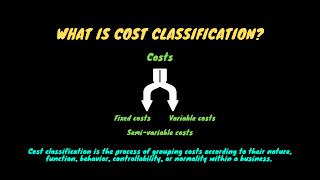Cost classification is the process of grouping costs according to their nature, function, behavior, controllability, or normality within a business. It helps businesses understand the different types of costs they incur and make more informed decisions about how to manage them.
There are several different types of costs that businesses must consider in order to understand their financial performance and make informed decisions. Some of the most common types of costs include:
Direct materials
These are the raw materials that go directly into the production of a product or service. Examples include the steel used to manufacture a car or the flour used to bake a cake.
Direct labor
These are the wages and benefits of the workers who are directly involved in the production process.
Manufacturing overhead
These are the indirect costs associated with manufacturing a product, such as utilities, property taxes, and equipment maintenance.
Marketing and selling expenses
These are the costs associated with promoting and selling a product or service, such as advertising, sales commissions, and packaging.
Administrative expenses
These are the costs of running the business, such as rent, salaries, and office supplies.
In addition to these types of costs, there are several other important classifications to consider. These include:
Fixed costs
These are costs that remain constant regardless of the level of activity. Examples include rent, salaries, and insurance.
Variable costs
Variable costs are costs that vary with the level of activity. Examples include direct materials and direct labor.
Semi-variable costs
These are costs that contain both fixed and variable elements. An example is a utility bill, which has a fixed charge for the connection and a variable charge based on usage.
Direct costs
These are costs that can be traced directly to a specific product or service. Examples include direct materials and direct labor.
Indirect costs
These are costs that cannot be traced directly to a specific product or service, but are necessary for the overall operation of the business. Examples include manufacturing overhead and administrative expenses.
Understanding the different types of costs that a business incurs is important for decision making and financial planning. By accurately identifying and tracking these costs, businesses can make informed decisions about pricing, resource allocation, and profitability.


